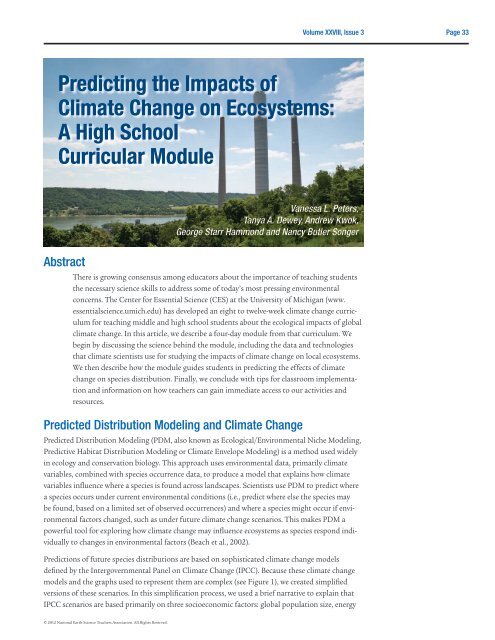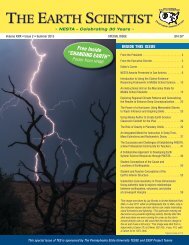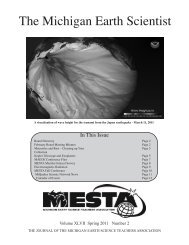The Earth Scientist
Fall 12.pdf - NESTA
Fall 12.pdf - NESTA
- No tags were found...
You also want an ePaper? Increase the reach of your titles
YUMPU automatically turns print PDFs into web optimized ePapers that Google loves.
Volume XXVIII, Issue 3<br />
Page 33<br />
Predicting the Impacts of<br />
Climate Change on Ecosystems:<br />
A High School<br />
Curricular Module<br />
Vanessa L. Peters,<br />
Tanya A. Dewey, Andrew Kwok,<br />
George Starr Hammond and Nancy Butler Songer<br />
Abstract<br />
<strong>The</strong>re is growing consensus among educators about the importance of teaching students<br />
the necessary science skills to address some of today’s most pressing environmental<br />
concerns. <strong>The</strong> Center for Essential Science (CES) at the University of Michigan (www.<br />
essentialscience.umich.edu) has developed an eight to twelve-week climate change curriculum<br />
for teaching middle and high school students about the ecological impacts of global<br />
climate change. In this article, we describe a four-day module from that curriculum. We<br />
begin by discussing the science behind the module, including the data and technologies<br />
that climate scientists use for studying the impacts of climate change on local ecosystems.<br />
We then describe how the module guides students in predicting the effects of climate<br />
change on species distribution. Finally, we conclude with tips for classroom implementation<br />
and information on how teachers can gain immediate access to our activities and<br />
resources.<br />
Predicted Distribution Modeling and Climate Change<br />
Predicted Distribution Modeling (PDM, also known as Ecological/Environmental Niche Modeling,<br />
Predictive Habitat Distribution Modeling or Climate Envelope Modeling) is a method used widely<br />
in ecology and conservation biology. This approach uses environmental data, primarily climate<br />
variables, combined with species occurrence data, to produce a model that explains how climate<br />
variables influence where a species is found across landscapes. <strong>Scientist</strong>s use PDM to predict where<br />
a species occurs under current environmental conditions (i.e., predict where else the species may<br />
be found, based on a limited set of observed occurrences) and where a species might occur if environmental<br />
factors changed, such as under future climate change scenarios. This makes PDM a<br />
powerful tool for exploring how climate change may influence ecosystems as species respond individually<br />
to changes in environmental factors (Beach et al., 2002).<br />
Predictions of future species distributions are based on sophisticated climate change models<br />
defined by the Intergovernmental Panel on Climate Change (IPCC). Because these climate change<br />
models and the graphs used to represent them are complex (see Figure 1), we created simplified<br />
versions of these scenarios. In this simplification process, we used a brief narrative to explain that<br />
IPCC scenarios are based primarily on three socioeconomic factors: global population size, energy<br />
© 2012 National <strong>Earth</strong> Science Teachers Association. All Rights Reserved.






